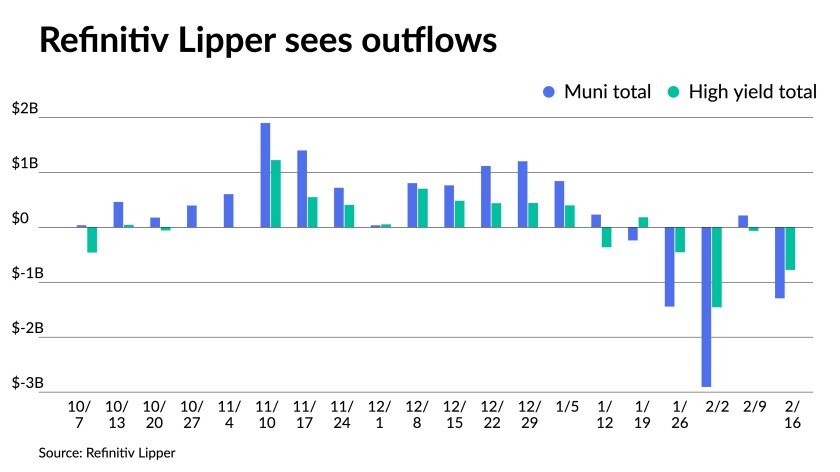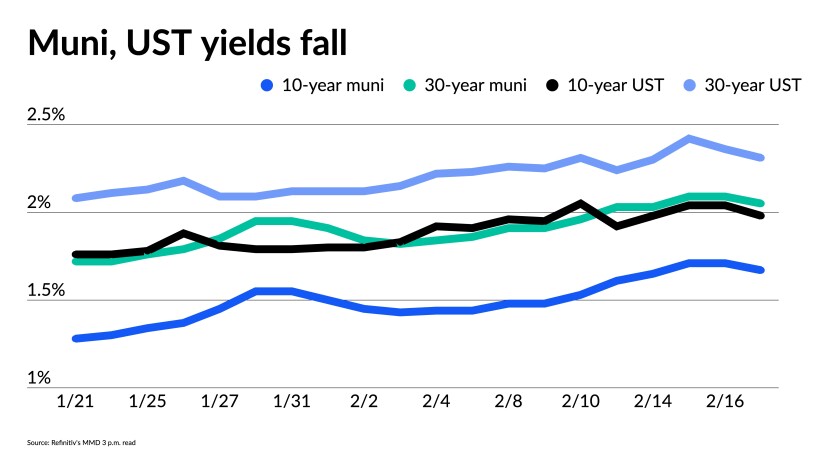Municipals were stronger on Thursday with yields falling for the first time since Feb. 3 on triple-A yield curves, but underperforming an improved U.S. Treasury market in a flight-to-safety bid while Refinitiv Lipper reported $1.3 billion of outflows from mutual funds.
Triple-A benchmark yields fell one to four basis points, with the larger bumps outside of four years. Trading was stronger out of the gates with bellwether names, such as Georgia, Montgomery County, Maryland and Washington State, seeing better clearing levels.
The municipal to UST ratio five-year was at 76%, 84% in 10 and 88% in 30, according to Refinitiv MMD’s 3 p.m. read. ICE Data Services had the five at 75%, the 10 at 87% and the 30 at 90% at a 4 p.m. read.
Few deals priced in the primary. Citigroup Global Markets priced for Forsyth County Water and Sewerage Authority, Georgia (Aaa/AAA//) of $94.085 million of refunding revenue bonds. The first tranche, $9.565 million of tax-exempt bonds, Series 2022A, saw bonds in 4/2023 with a 4% coupon yield 0.97%, 4s of 2027 at 1.65%, 4s of 2032 at 1.98% and 4s of 2034 at 2.14%, callable 4/1/2032.
The second tranche, $84.52 million of taxable bonds, Series 2022B, had all bonds priced at par: 1.499% in 4/2023, 2.112% in 2027, 2.554% in 2032, 3.154% in 2037 and 3.39% in 2044, callable 4/1/2032.
Muni investors are considering the impact of rising yields on the asset class as the Fed continues to signal its plan to hike rates considerably this year, according to Morgan Stanley strategists.
“This means accounting for some muni-specific risks that could amplify price downside: negative convexity as bonds shift from pricing to the call to pricing to maturity and the tax impact of the de minimis rule on bonds trading at too deep a discount to par,” they said.
They said the good news is that before these muni-specific concerns saturate the market, the yield curve must undergo a far greater rate hike than certain forecasts, such as 10-year USTs climbing to 2.30% by year-end.
Negative price convexity from extension and de minimis risks are key reasons why munis could underperform fixed-income alternatives — such as the largely non-callable investment grade corporate bond market, —on rising rates, given that about 70% of munis have a call option and 90% of those are currently pricing to the call, they said.
However, Morgan Stanley analysts said rates will need to increase another 60 to 100 basis points before these variables become a widespread threat to the market.
“Furthermore, given our base case that 10-year USTs yields only rise 30 basis points from here, we see the most likely outcome as these special risks being relegated to smaller pockets of the market in 2022,” they said.
Even if there are no dangers particular to munis, muni investors should have a portfolio plan that prepares for increasing rates. Rising rates are, by definition, negative for prices. In a rising-rate environment, investor demand is also in danger, they said.
Mutual funds see outflows
In the week ended Feb. 16 weekly reporting tax-exempt mutual funds saw investors pull more money out with Refinitiv Lipper reporting $1.293 billion of outflows Thursday, following an inflow of $215.512 million the previous week.

Exchange-traded muni funds reported inflows of $493.186 million after inflows of $754.758 million in the previous week. Ex-ETFs, muni funds saw outflows of $1.786 billion after $539.246 million of outflows in the prior week.
The four-week moving average fell to negative $1.354 billion from negative $1.090 million in the previous week.
Long-term muni bond funds had outflows of $1.176 billion in the last week after inflows of $222.678 million in the previous week. Intermediate-term funds had outflows of $114.022 million after $86.388 million of outflows in the prior week.
National funds had outflows of $975.591 million after inflows of $297.247 million the previous week while high-yield muni funds reported $775.854 million of outflows after $65.586 million of outflows the week prior.
Secondary trading
Florida Board of Education 5s of 2023 at 0.91% versus 0.91%-0.87% Wednesday.) Georgia 5s of 2024 at 1.25%-1.21%. Ohio 5s of 2025 at 1.37%.
Georgia 5s of 2029 at 1.61% versus 1.65% Wednesday. Montgomery County, Maryland 4s of 2029 at 1.66% versus 1.68% Wednesday. New York State Urban Development Corp. 5s of 2030 at 1.82%-1.81%.
Metropolitan Water District of Southern California 5s of 2035 at 1.84% versus 1.89%-1.88% Wednesday. NYC TFA 5s of 2037 at 2.17%-2.16% versus 2.18% Wednesday. University of California 5s of 2038 at 2.03%-2.02%.
Washington 5s of 2043 at 2.15%-1.96%. Washington 5s of 2044 at 2.17% versus 2.23%-2.22% Wednesday. San Diego County Water Authority 5s of 2047 at 2.10%-2.09%.
AAA scales
Refinitiv MMD’s scale was bumped up to four basis points at the 3 p.m. read: the one-year at 0.84% (unch) and 1.11% (unch) in two years. The five-year at 1.41% (-3), the 10-year at 1.67% (-4) and the 30-year at 2.05% (-4).
The ICE municipal yield curve was bumped: 0.85% (-2) in 2023 and 1.15% (-3) in 2024. The five-year at 1.39% (-2), the 10-year was at 1.71% (-3) and the 30-year yield was at 2.08% (-3) in a 4 p.m. read.
The IHS Markit municipal curve was also bumped: 0.83% (unch) in 2023 and 1.10% (unch) in 2024. The five-year at 1.42% (-3), the 10-year at 1.67% (-3) and the 30-year at 2.06% (-3) at a 4 p.m. read.
Bloomberg BVAL was bumped: 0.85% (-1) in 2023 and 1.09% (unch) in 2024. The five-year at 1.42% (-2), the 10-year at 1.67% (-3) and the 30-year at 2.05% (-3) at a 4 p.m. read.
Treasuries were better while equities sold off.
The two-year UST was yielding 1.470% (-5), the five-year was yielding 1.842% (-8), the 10-year yielding 1.966% (-7), and the 30-year Treasury was yielding 2.297% (-5) at the close. The Dow Jones Industrial Average lost 622 points or 1.78%, the S&P was down 2.12% while the Nasdaq lost 2.88% at the close.
Economy
Inflation concerns continue, while a read of manufacturing showed some slowing with prices still elevated, and initial claims for unemployment unexpectedly rose in the week.
Economic growth slowed in February, according to the Federal Reserve Bank of Philadelphia’s manufacturing index, and while prices paid eased slightly, but remained elevated, the prices received index rose. “More than 54% of the firms reported increases in prices of their own manufactured goods, while 4% reported decreases,” according to the survey.
Respondents expect to raise prices 5.0% in the next 12 months, down from 5.3% in November when manufacturers were last queried. The firms upped expectations for wage hikes to 5.0% from 4.8% in November, while they still expect inflation to run 5.0% in the year.
Separately, few homes were started in January: 1.638 million compared to 1.708 million in December, while building permits rose to 1.899 million from 1.885 million.
Builders said supply shortages have delayed construction at a time when the supply of homes for sale remains subdued. “Fueled by higher mortgage rates and construction costs, declining housing affordability will continue to affect the home building market in 2022,” said National Association of Home Builders Chief Economist Robert Dietz.
“While supply chain bottlenecks are easing for some industries, the construction sector will continue to face delays,” said Grant Thornton Economist Yelena Maleyev. “With building permits rising, the pipeline for new construction remains firm.”
But higher mortgage rates should cut demand for single-family homes, she said, “but long backlogs should blunt the blow of higher rates to construction activity. That, ironically, makes the Federal Reserve’s job of cooling inflationary pressures even harder in the near-term.”
Meanwhile, initial jobless claims gained to 248,000 in the week ended Feb. 12, up from 225,000 a week earlier.
“Inflation, the pandemic and geopolitical concerns still have some plot twists yet to be resolved, underscoring the high level of economic uncertainty currently prevailing,” said Mark Hamrick, senior economic analyst at Bankrate. “There’s a bit of fog” around the numbers, which climbed for the first time in four weeks.
And while the increase was not expected, he said, one week’s data doesn’t make a trend. Also, Hamrick noted, the continuing claims number declined.
Informa: Money market muni funds rise
Tax-exempt municipal money market fund assets rose by $43.7 million, bringing their total to $85.84 billion for the week ending Feb. 15, according to the Money Fund Report, a publication of Informa Financial Intelligence.
The average seven-day simple yield for the 148 tax-free and municipal money-market funds remained at 0.01%.
Taxable money-fund assets lost $53.21 billion, bringing total net assets to $4.405 trillion in the week ended Feb. 7. The average seven-day simple yield for the 776 taxable reporting funds increased to 0.02% from 0.01% a week prior.
